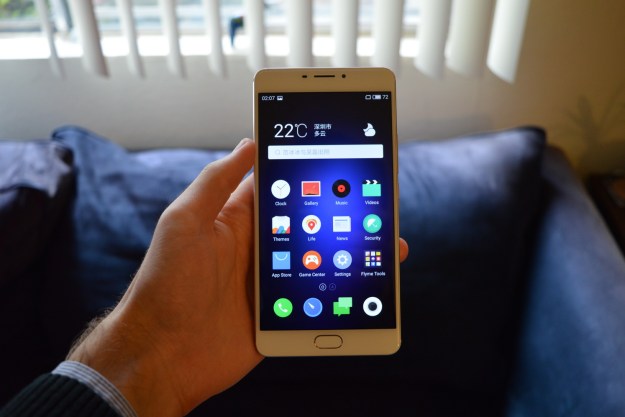
“It's not a bad phone, but Meizu's M3 Max just can't keep up.”
- Nice battery life
- Great design
- Easy to use software design
- Unpolished OS
- Outdated performance
- Low-res display
- Lackluster camera
The smartphone industry has changed significantly over the past few years. At one time, it was all about making something that could easily fit in your pocket; now the line between tablet and phone blurs with every passing day.
Meizu’s latest device, the M3 Max, embodies that trend, boasting a hefty 6.0-inch display. But does its performance under the hood match its giant look? We took the phone for a spin to find out.
Design
As has been the case with multiple Meizu phones we’ve reviewed over the past few months, the designers of this model clearly took inspiration from a certain fruity product — or in this case the Plus version of one. That this is a blatant iPhone copy isn’t necessarily a bad thing, however: The phone looks great. From its minimalistic, symmetric styling to the extremely thin, nice-feeling profile, the device really screams quality, at least when it comes to design.
Of course, with a 6-inch display and a body measuring 6.42 × 3.21 × 0.31-inches, this phone is an absolute beast, one well and truly into phablet territory. In fact, it’s even bigger than the old Nexus 6, the whale of a phone Google released with Motorola a few years back. If you’re looking for a big-screened phone, this device has the goods. We recommend trying it out first, though; some might find it too big.
While big, the phone doesn’t feel unwieldy – quite the opposite. Its 0.31-inch thickness helps it feel nice and sleek, especially for someone who’s used to phablet-sized phones. If this is your first phablet, it will take a big of getting used to, but that’s true of any phablet – not just this one.
One of the nice touches to this phone is its symmetry. The camera (which doesn’t sit under a bump), is centered along the back, and even the front-facing camera, which sits on the right of the top speaker, is offset by an ambient light sensor on the left. Details like this really put the phone over the edge and give it that premium look. It’s one thing to copy Apple, but it’s another thing entirely to copy Apple while adding your own spin to the design, as Meizu has done.
Flyme OS continues that iPhone-copying tradition
Design isn’t the only signal that Meizu was inspired by Apple. Take a look at the phone’s software, an Android 6.0 Marshmallow overlay built by Meizu called Flyme OS, and you’ll see similarities to iOS. For example, there’s no app drawer – instead, all of your apps live on one of the home screen panes. Flyme OS also has a series of tool apps, which came pre-installed in a folder called Flyme Tools.
The device really screams quality, at least when it comes to design.
Some of those tools are actually pretty darn useful. Take for example the Toolbox app itself, which offers a flashlight, level, ruler, and “mirror” (which just uses the front-facing camera) – all in one app that looks great and is easy to use. Sure, some of those things you’ll pull out only once every few months, but they’re nice options to have nonetheless.
Flyme OS seemed slightly less polished on the M3 Max than on other Meizu phones we’ve tested, however. There are multiple spelling or grammar errors, and some elements don’t change language to English. On top of that, the phone came with a ton of apps that are irrelevant to a Western audience. Weibo, Tencent, dianping, and TaoBao all made an appearance, and we promptly placed them at the back of the list or uninstalled them. We can only assume that the review unit we received didn’t have a fully polished version of Flyme OS.
Performance
The M3 Max features a MediaTek Helio P10 octa-core processor, which boasts four 1.8GHz Cortex-A53 cores and four 1.0GHz Cortex-A53 cores. Couple it with 3GB of RAM and you have quite a workhorse on your hands — at least on paper.
During day-to-day use, the phone performed well. Sure, there were a few stutters now and then, but nothing to be overly concerned about and nothing more than other top-tier devices on the market.
Unfortunately, day-to-day use is about where performance stops on this phone. The device scored a relatively uninspiring 49,023 on AnTuTu, putting it well below the Pro 5’s 79,952, the LeEco Le2 Pro’s 94,345, and even the two-year-old Nexus 6’s 75,095. If you’re looking for a mobile gaming companion, this is not the phone for you. One of the M3 Max’s biggest competitors, the similarly priced Xiaomi Mi Max, also far exceeds the M3 Max, sitting at 71,885.
That’s really quite unfortunate. Just because these phones come with a budget price tag doesn’t mean they need to be low-powered – just look at the OnePlus 3, which boasts a Qualcomm Snapdragon 820 processor at under $400.
It’s important to note that benchmarks aren’t everything. If all you really need to do is message, talk, and maybe do a little web-browsing, you’ll still have plenty of power to do that. Ask for more than that, however, and you might wish you had sprung for something more powerful.
Display and battery
The disappointment continues with the phone’s display. We didn’t have issues with the resolution, despite the fact that it’s only 1080p. The frustration was the fact that its an LCD screen, while other Meizu phones have nicer AMOLED displays. The colors were a little flatter, the display wasn’t as bright, and overall it just wasn’t as impressive.
The difference wasn’t really noticeable until we placed the phone side-by-side with the Meizu Pro 6 – so if you don’t really care about the display you probably won’t notice any issues. If you’re used to higher quality, you’ll probably be disappointed.
The trade-off to a low resolution display is better battery life, and the 4,100mAh battery in this phone certainly does the job. Some enthusiasts were expecting a larger 5,000mAh battery before the phone was officially announced; that would have been overkill. The fact is, this phone lasts well over a day, and into two if you’re conservative with your use. Most people charge their phones every night, and if you’re in that habit you won’t find yourself on the go during the day and out of juice. Add in the quick-charging feature, which fills the battery to 50 percent in 30 minutes, and you’ve got a device that shouldn’t ever run out of battery.
Camera
We’ve reviewed a few Meizu phones over the past year, and so far the company has failed to capture our imagination when it comes to the camera. The M3 Max doesn’t change that.
The camera app itself is well laid-out; it offers quick and easy access to features like HDR and gridlines, as well as modes like manual, beauty, macro, and more. That doesn’t mean that the photos you take will be great. That’s not to say that they’re terrible, just that if you’re looking for a device to really get your photography juices flowing, this isn’t it. The 13MP rear-facing camera — which offers an f/2.2 aperture, phase detection autofocus, and a dual-LED flash — is fine for those that simply want to take a snap every now and then, but not much more.
As you can see in our shots, HDR mode does help a little in certain situations, like in low-light. In others, it ends up looking fake and overexposed, so you won’t want to keep
The front-facing camera is, again, fine for what it offers, but nothing special. The 5MP sensor will do the job for the occasional selfie.
Warranty
Meizu’s phones have a 1 year warranty, under which phones can be fixed free of charge under “normal circumstances.” That warranty, however, is only valid in certain countries including China, India, Malaysia, and some others. To check on your country, ask your phone retailer before you buy the device.
Our Take
Meizu hasn’t made a bad phone by any means, but it has made one that is easily beat by the competition. Its processing power is especially worrying – if a phone can’t handle the apps of today, then forget about it being future-proof and being able to handle the apps of 2017 and beyond.
Is there a better alternative?
The Xiaomi Mi Max a similar size but offers a Snapdragon 650 processor, a 16MP camera, and a 4,850mAh battery — meaning there’s really not much reason to buy this phone unless you’re a die-hard Flyme OS fan who wants a big screen. That’s especially true considering the fact that the Meizu M3 Max comes at 1,699 yuan, which equates to around $252, while the Xiaomi Mi Max comes at 1499 yuan, or around $222. Buy the Mi Max — you’ll save a few bucks and get a better phone, too.
How long will it last?
Like most phones, the M3 Max should last around two years, as long as you take care of it. Unfortunately, that time frame is seriously shortened considering the fact that it’s waterproof, so if you drop it in the bathtub you’re going to be in trouble.
Should you buy it?
Probably not. While it boasts a nice battery life, a beautiful design, and some neat software, it’s lacking in key areas like performance, camera, and display.














